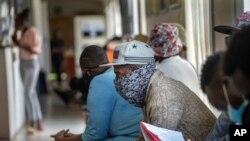The first shots of a vaccine against the coronavirus may be administered before year's end if all goes according to schedule.
Biotech company Moderna announced Monday that the U.S. Food and Drug Administration will likely consider whether to grant its vaccine emergency use authorization on or about December 17.
Moderna follows drugmaker partners Pfizer and BioNTech, who have an FDA meeting scheduled for December 10.
Another meeting on Tuesday will provide recommendations on who should get access to the limited initial supply of vaccines once they are approved.
‘Impressive’
The pace of development has been unprecedented for a new vaccine against a disease that was unknown a year ago.
In nearly five decades working in immunization, Associate Director Walter Orenstein of the Emory University Vaccine Center said he has never seen anything like it.
"It’s just really impressive to have potential vaccine candidates available for widespread use in this short a period."
The companies and the U.S. government put billions of dollars into developing the vaccines, which Orenstein said allowed them to move this fast without compromising safety.
Distribution is expected to start immediately once the FDA gives each manufacturer the green light.
Both Moderna and the Pfizer/BioNTech team have released results from clinical trials showing that their vaccines are more than 90% effective.
The FDA will get a closer look at the data than what the public has seen through company press releases.
The agency will also share that data with a group of experts outside the agency and not affiliated with the manufacturers, known as the Vaccines and Related Biological Products Advisory Committee (VRBPAC).
The FDA does not have to get VRBPAC's recommendation in order to issue an emergency use authorization. But the American public has grown increasingly skeptical of the vaccine. Having independent experts review the results should help build trust, said L.J. Tan, chief strategy officer at the Immunization Action Coalition.
"The fact that (FDA) is putting this in front of VRBPAC on December 10 is a good thing," he said.
Emergency use
The panel will be paying especially close attention to safety data, which has not been fully disclosed.
Side effects reported so far have not been serious, but they also have not been trivial. They include headaches, muscle aches, fever and fatigue, which could be mistaken for influenza or even COVID-19, the disease caused by the coronavirus. These symptoms generally cleared up in a day or so.
The companies will present about two months of safety data for vaccine recipients. Tan said that is usually long enough for the most serious side effects to show up.
But one reason developing vaccines take so long is because they usually have been tested for several years before the FDA grants full approval.
The requirements for emergency use authorization are lower, Orenstein said.
"Emergency use authorization is a judgment that, given the public health emergency that we're facing — a thousand to 2,000 people dying a day — that the product appears to be safe and effective enough to use," he said.
Limited supply
Moderna said it expects to have 20 million doses available in the United States by the end of 2020. Pfizer forecasts 50 million doses worldwide this year.
That will not be enough for everyone. Both vaccines require two doses for full potency, which means only 35 million people can be fully immunized.
The CDC's Advisory Committee on Immunization Practices (ACIP) has scheduled a vote Tuesday, Dec. 1 on recommendations for allocating the initial supplies of vaccine.
Front-line health care workers are widely expected to top the list.
That includes about 21 million people, according to CDC estimates.
Who gets the vaccine next is a trickier question. General recommendations include the elderly, essential workers and people with medical problems that raise their risk of dying of COVID-19. The latter two categories are open to interpretation.
ACIP's schedule for Tuesday does not appear to include making those recommendations.
"They may put that off until a time when they can be assured there will be more doses to reach more people," Orenstein said.
The next complication will be distribution.
The Pfizer vaccine needs to be kept at temperatures much colder than standard freezers. Larger medical centers would likely have the equipment.
"They should get the Pfizer vaccine," Tan said. “Save the Moderna (vaccine) for rural hospitals. But that means additional logistical challenges, because now you've got to separate the vaccine at the source so that they go to the right places at the right time."
Regulators will have other vaccines to consider in the coming months, as well. Pharmaceutical company AstraZeneca's vaccine has demonstrated promising results, and drugmaker Johnson & Johnson's vaccine is nearing the end of a clinical trial.









